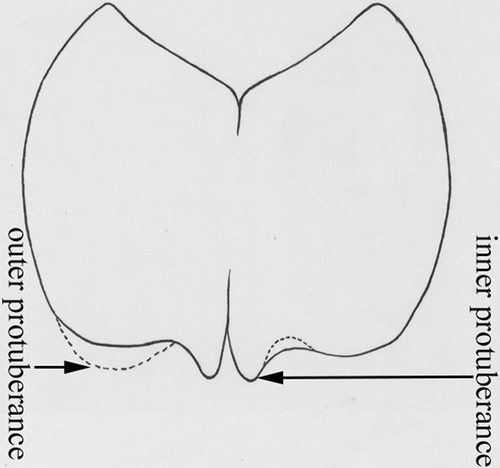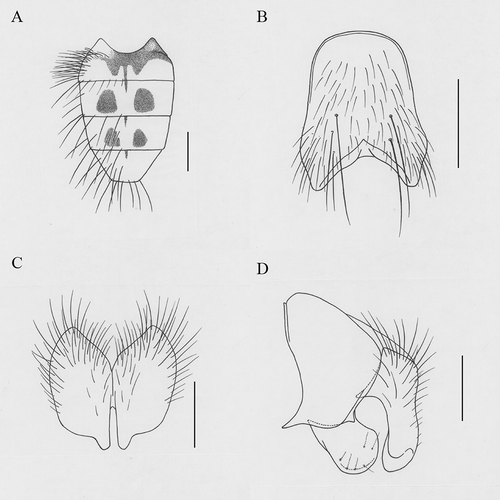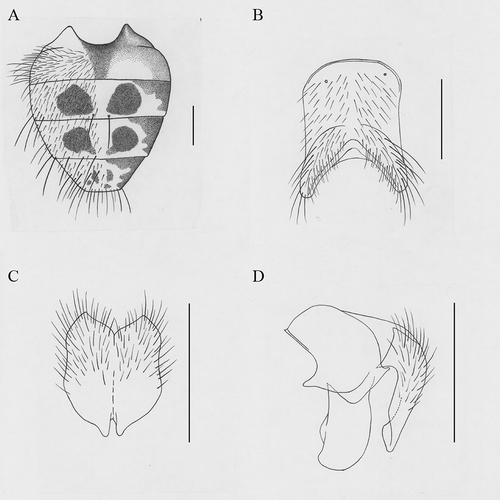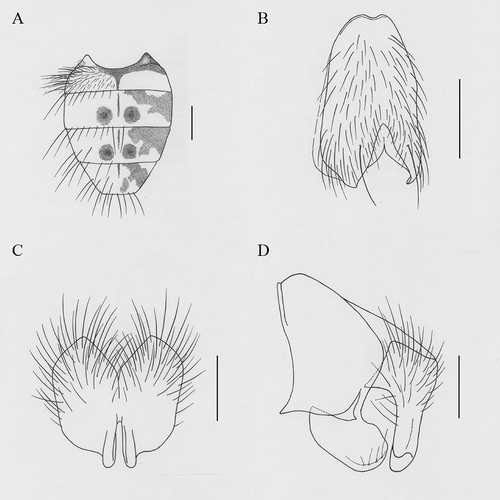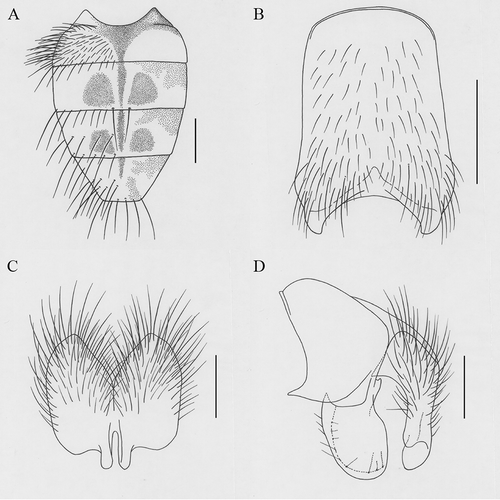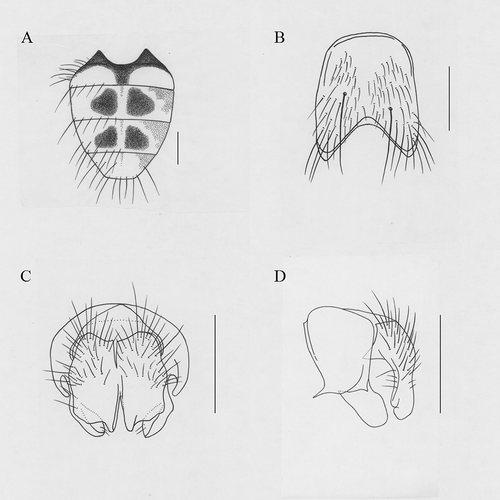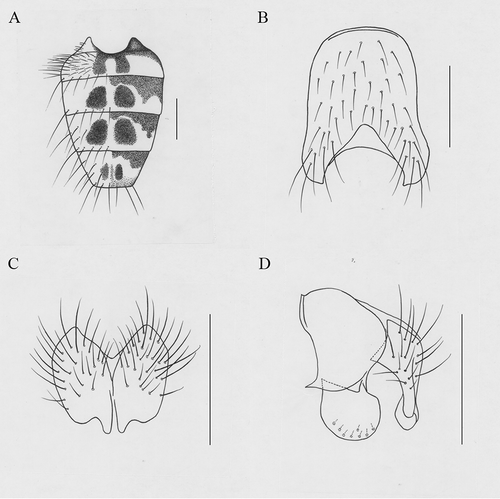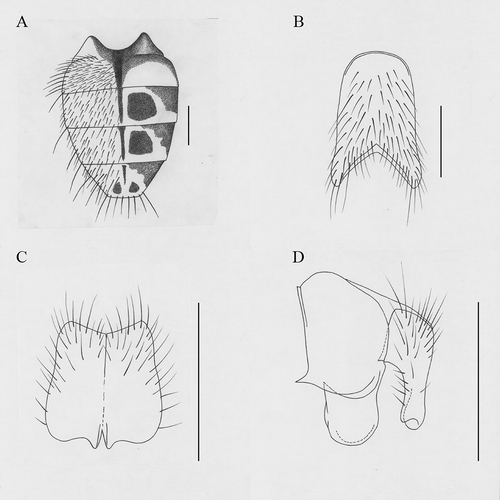Abstract
Nine new species of Helina annosa-group from China, namely H. longievecta sp. nov, H. longisurstyla sp. nov, H. midmargiseta sp. nov, H. nigriabdomilis sp. nov, H. nivimonta sp. nov, H. setosiannosa sp. nov, H. shii sp. nov, H. subfloscula sp. nov. and H. subnigriabdomilis sp. nov, are described and illustrated. Diagnosis of this group, a key and distributions of the species are also given.
http://www.zoobank.org/urn:lsid:zoobank.org:pub:3516C15F-F4AA-4391-B944-84556792CC83
Introduction
Helina Robineau-Desvoidy, established in 1830, is the second largest genus in the family Muscidae, distributed in all zoogeographic regions of the world, and comprises about 660 scientific names (over 530 species), the majority of which are from the Palaearctic region (Emden Citation1951, Citation1965; Hennig Citation1957–1958; Huckett Citation1965; Pont Citation1977, Citation1980, Citation1986, Citation1989; Xue Citation1998; De Carvalho et al. Citation2005; Wang et al. Citation2008; Xue and Tian Citation2012). The genus Helina was classified into seven groups by Ringdahl for the first time in Citation1924, and then classified into 21 groups by Ringdahl in Citation1949. Although Ringdahl did a tremendous amount of work on this genus, his conclusions were preliminary and need further investigation. Ringdahl (Citation1956) did not quote these groups in his book Svensk Insektfauna, but Hennig (Citation1957–1958) accepted them in his monograph of Palaearctic Muscidae, although there was no in-depth study. Emden (Citation1951, Citation1965) and Skidmore (Citation1985) further divided this genus into subgenera according to morphological or biological characters. However, some of the groups are now redefined as genera, while others have been placed in synonymy. Modern taxonomists such as Pont (Citation1977, Citation1980, Citation1986, Citation1989) did a large amount of analysis and research about generic synonymies and homonymies in the genus Helina (Xue and Tian Citation2012).
China is located in two zoogeographic regions, namely the Palaearctic and the Oriental regions. A large number of species of Helina are found in China. The domestic study of the Helina genus began in the early 1980s. From the early 1980s to 1990s, the species of genus Helina rose from more than 10 species up to 69 species (Fan Citation1992). By 1998, Xue and Chao, in the book Flies of China, reported 96 species of genus Helina in China (Xue and Chao 1998). According to statistics, so far 229 species in the genus Helina are known from China (Xue and Tian Citation2011; Xue et al. Citation2012; Wang Citation2013). This paper reports on 43 species (including 41 endemic Chinese species) and gives the diagnosis of the Helina annosa-group; it establishes the model of male cerci (), and describes nine new species. A key and the distribution of the species are also given. In addition, this group was classified into two subgroups according to whether the centre of the scutellum ventrally is with hairs or without hairs, namely the Helina annosa-subgroup and the Helina evecta-subgroup.
Some authors believe that Helina dianica Qing and Feng, Citation2005 and Helina sarmentosa Fang and Fan, Citation1993 are synonymies according to their same type localities. In this paper, the authors scrutinized and compared the original descriptions of the two species, and found that there was still some difference between the two species both in terminalia characteristics and in external morphology characteristics. Different characteristics are as follows. Helina dianica Qing and Feng, Citation2005, circus narrow in distal half, hollow of circus deep in distal margin, surstylus curved backwards; fr on lower half of frons, parafacial about 1.4 times as broad as postpedicel, length of postpedicel about 2.6 times as long as its width, thorax with dense, grey pruinosity, lateral surface of scutellum bare, cross-veins r-m and dm-cu clouded, haltere red orange, tergite 5 with a pair of stripe-like patches, sternite 1 bare. Helina sarmentosa Fang and Fan, Citation1993, circus broad in distal half, hollow of circus shallow in distal margin, surstylus straight; fr complete, parafacial about 2.0 times as broad as postpedicel, length of postpedicel about 3.0 times as long as its width, pruinosity of thorax indistinct, lateral surface of scutellum with hairs, cross-veins r-m and dm-cu not clouded, haltere orange yellow, tergite 5 without patches, sternite 1 with hairs. According to the above discussion and analysis, the authors beg to differ from the opinion and divide them into different species.
Material and methods
The type specimens of nine new species are all deposited in the Institute of Entomology, Shenyang Normal University, Shenyang, China. This study was based on the research method of combining external morphology with terminalia characteristics. The terminology followed is that of McAlpine (Citation1981). Absolute measurements are given in mm. The following abbreviations are used: IESNU, Institute of Entomology, Shenyang Normal University; ors, orbital setae; fr, frontal setae; prst acr, presutural acrostichal setae; acr, acrostichal setae; dc,dorsocentral setae; psut dc, postsutural dorsocentral setae; ial, intra-alar setae;; pra, prealar setae; av, anteroventral setae; a, anterior setae; ad, anterodorsal setae; pd, posterodorsal setae; p, posterior setae; pv, posteroventral setae; v, ventral setae; r-m, radio-medial cross-vein; dm-cu, discal medial-cubital cross-vein; R4+5, fourth and fifth branches of radius; and M, media vein.
Diagnosis of Helina annosa-group (males)
Notopleuron and meron below spiracle with hairs, lateral surface and ventral lateral margin of scutellum usually with black hairs (Helina nigriannosa, Helina floscula, Helina plumipostitibia and Helina subfloscula bare), hind tibia usually with strong av and setiform p, basisternum of prosternum and radial node bare, centre of scutellum underside of Helina annosa-subgroup bare (Helina evecta-subgroup with hairs), legs black, at most the base of tibia yellow (such as Helina luyashanensis and Helina sinoccidentala). Outer protuberance of cercus always shorter than inner protuberance.
Centre of scutellum beneath with hairs (Helina evecta-subgroup)2
Centre of scutellum beneath bare (Helina annosa-subgroup)7
Sternite 1 bare3
Sternite 1 with hairs4
Costal spine indistinct, R4+5 and M diverging in distal part, cross-veins not clouded; mid femur with 4 pv in basal half, hind femur with strong av in apical two-fifthsHelina luyashanensis
Costal spine short, R4+5 and M parallel, r-m clouded; mid femur with complete pv row, 5 strong in basal, hind femur with strong av in apical halfHelina subevecta
Arista short plumose, the longest aristal hairs about a half width of postpedicelHelina nemorum
Arista plumose or long plumose, the longest aristal hairs at least equal to width of postpedicel5
Cross-vein r-m clouded, fore tibia without pHelina mimevecta
Cross-veins not clouded, fore tibia with p6
Lateral surface of scutellum with hairsHelina evecta
Lateral surface of scutellum bareHelina pleuranthus
Sternite 1 bare8
Sternite 1 with hairs18
Arista short plumose, the longest aristal hairs about two-thirds width of postpedicelHelina brachytophalla
Arista plumose or long plumose, the longest aristal hairs at least equal to width of postpedicel9
Inner vitta of scutum reaching scutoscutellar suture10
Inner vitta of scutum not reaching scutoscutellar suture13
Pra absent11
Pra distinct12
Frons about 2.5 times as broad as anterior ocellus; basicosta dark orange; fore tibia without p, mid femur with 4 to 5 strong pv, mid tibia with 3 pHelina jiaodingshanica
Frons about 1.3 times as broad as anterior ocellus; basicosta yellow; fore tibia with 3 p, mid femur with 8 to 10 pv, mid tibia with 6 to 7 pHelina dianica
Length of postpedicel about 3.5 times as long as width, costal spine indistinct, cross-veins not clouded, fore tibia with 2 to 3 pHelina nigriannosa
Length of postpedicel about 2.5 times as long as width, costal spine short, cross-veins clouded, fore tibia without median pHelina barkamica
Lateral surface of scutellum bare, ventral lateral margin with hairsHelina shuensis
Lateral surface of scutellum with hairs, ventral lateral margin bare or with hairs14
Ventral lateral margin of scutellum with hairs15
Ventral lateral margin of scutellum bare16
Cross-vein r-m not clouded; hind femur with 4 av in apical one- quarter, hind tibia with 4 avHelina azaleella
Cross-vein r-m clouded; hind femur with 9 to 10 av in apical three-quarters, hind tibia with 9 to 10 av in basal two-thirdsHelina subnigriabdomilis Xue and Sun, sp. nov.
Pra absentHelina sichuanica
Pra distinct17
Fore tibia with 1 p, lateral lobe of sternite 5 verrucoseHelina mimifica
Fore tibia with 2 to 3 p in apical half, lateral lobe of sternite 5 broad, not verrucoseHelina emeishanana
Pra absent19
Pra distinct22
Fore tibia with 2 to 4 median pHelina sarmentosa
Fore tibia without median p20
Inner vitta of scutum not reaching scutoscutellar sutureHelina maquensis
Inner vitta of scutum reaching scutoscutellar suture21
R4+5 and M diverging in distal part, haltere yellow; mid femur with complete pv row, strong in basal part, mid tibia with 6 to 7 p, hind tibia with 5 ad; distal part of cercus without outer protuberance in posterior viewHelina floscula
R4+5 and M straight, haltere dark orange; mid femur with pv row in basal two-fifths, mid tibia with 4 to 5 p in apical two-thirds, hind tibia with 3 to 4 ad; distal part of cercus with distinct outer protuberance in posterior viewHelina subfloscula Xue, sp. nov.
Lateral surface of scutellum bare23
Lateral surface of scutellum with hairs25
Costal spine absentHelina plumipostitibia
Costal spine distinct24
Cross-veins clouded; mid femur with 3 to 4 pv in basal half, hind tibia with 3 to 4 av, ad 4Helina xinanana
Cross-veins not clouded; mid femur with complete pv row, hind tibia with 4 to 5 av, ad 2 to 3Helina midmargiseta Xue, sp. nov.
Ventral lateral margin of scutellum bare26
Ventral lateral margin of scutellum with hairs29
Katepisternal setae 1:2Helina quadratisterna
Katepisternal setae 2:227
Mid tibia with 7 to 9 strong pHelina setipostitibia
Mid tibia at most with 5 p28
Arista plumose, the longest aristal hairs subequal to width of postpedicel; mid tibia with 5 p, hind femur with 5 to 6 av in apical one-thirdHelina nigriabdomilis Xue, sp. nov.
Arista plumose, the longest aristal hairs longer than width of postpedicel; mid tibia with 3 to 4 p, hind femur with 3 to 4 strong avHelina annosa
Fore tibia without median p30
Fore tibia with median p38
Inner vitta of scutum not reaching scutoscutellar suture32
Inner vitta of scutum reaching scutoscutellar suture31
Length of postpedicel about 4.0 times as long as its width, hind tibia with 7–8 adHelina setosiannosa Xue, sp. nov.
Length of postpedicel about 3.0 times as long as its width, hind tibia with 2 adHelina tuomuerra
Mid femur with pv only in basal half33
Mid femur with complete pv row34
Frons subequal to anterior ocellus in width; legs black, only bases of tibiae orange yellow, hind tibia with 5 to 6 av; anterior margin of surstylus cavateHelina sinoccidentala
Frons about 1.5 times as broad as anterior ocellus; legs complete black, hind tibia with 7 to 8 av; anterior margin of surstylus curvate forwardHelina gongshanensis
Cross-veins cloudedHelina maae
Cross-veins not clouded35
Costal spine absent36
Costal spine distinct37
The longest aristal hairs about twice as long as width of postpedicel; hind tibia with 5 av in apical half; tergite 5 with median orange vitta; length of surstylus at most 1.3 times as long as its widthHelina baoshanensis
The longest aristal hairs about 2.5 times as long as width of postpedicel; hind tibia with 5 av in middle part; each tergite without vitta; length of surstylus at least twice as long as its widthHelana longisurstyla Xue and Sun, sp. nov.
Hind femur without pv, hind tibia with 13 strong p in middle partHelina septentrionalis
Hind femur with 2 to 3 pv only in apical part, hind tibia with a row of setiform setae in basal halfHelina longievecta Xue, sp. nov.
Inner vitta of scutum reaching scutoscutellar sutureHelina fica
Inner vitta of scutum not reaching scutoscutellar suture39
Cross-veins clouded40
Cross-veins not clouded42
Frontal setae 5 pairsHelina shii Xue, sp. nov.
Frontal setae 7 to 8 pairs41
Arista plumose, the longest aristal hairs subequal to width of postpedicel, costal spine absentHelina pedana
Arista long plumose, the longest aristal hairs about 1.7 times as long as width of postpedicel, costal spine distinctHelina platycephala
Arista plumose, the longest aristal hairs subequal to width of postpedicel; hind femur with 4 to 5 av in apical one-third; outer protuberance of cercus distinctHelina nivimonta Xue, sp. nov.
Arista long plumose, the longest aristal hairs longer than width of postpedicel; hind femur with 5 to 6 av in apical half; cercus without outer protuberanceHelina subfica
Key to species of Helina annosa-group (males)
Distribution of species of the Helina annosa-group from China and descriptions of nine new species
Helina annosa (Zetterstedt, Citation1838)
Distribution
Shanxi, Sichuan, Yunnan, Heilongjiang, China; Japan; Israel; Europe (type-locality:
Sweden); North America; Nearctic Region.
Helina azaleella Feng et al. Citation2004
Distribution
Jilin, Heilongjiang, Liaoning, Hebei, Shanxi, Gansu, Xinjiang, China;Japan, Russia, Europe (type-locality: England), Israel, Syria, North Africa, Nearctic region, Neotropical region, Afrotropical region, Oriental region.
Helina fica Xue, Citation1985
Distribution
Shanxi, Hebei, Liaoning (type-locality: Hengren, Benxi), Hubei, Sichuan, Yunnan.
Helina floscula Feng and Xue, Citation2003
Distribution
Sichuan (type-locality: Hanyuan)
Helina longievecta Xue, sp. nov.
(A–D)
Type material
Holotype
One male (IESNU), China, Forestry centre of Guamagou, Ningxia Hui Autonomous Region, 38°28' N, 106°15' E, altitude 2200 m, 6 July 2008, J.Y. Liu.
Paratypes
One male (IESNU), same data as holotype.
Etymology
The specific name is based on the similarity of new species with Helina evecta (Harris, Citation1780), with arista length of the former more than twice width of postpedicel, the latter subequal to the width of postpedicel.
Distribution
China, Ningxia Hui Autonomous Region, Forestry centre of Guamagou.
Remarks
This new species is similar to H. evecta (Harris, Citation1780), but differs from it as follows: parafacial about 1.2 times as broad as postpedicel; the longest aristal hairs about 2.2–2.5 times as long as the width of postpedicel; cross-veins r-m and dm-cu indistinctly clouded; tergite 5 with a pair of small patches.
Description (based on holotype)
Male
Body length 6.9–7.2 mm.
Head
Eyes with dense, medium long and orange ciliae; frons about twice as broad as anterior ocellus; frontal vitta black, linear at narrowest point; 6–7 pairs of fr on lower half of frons, without ors; ocellar seta shorter than the lower fr length; fronto-orbital plate and parafacial with light grey pruinosity, parafacial about 1.2 times as broad as postpedicel; antenna black, postpedicel thin and long, length about 2.5 times longer than width; arista long plumose, the longest hairs about 2.2–2.5 times as long as the width of postpedicel; lunule brownish; epistoma not proeminent; vibrissal angle situated behind frontal angle; anterior margin of gena with one row of upcurved setulae, genal and postgenasetulae black; gena with grey pruinosity, genal height about two-ninths of eye height; epicephalon with black hairs; proboscis short, with grey pruinosity, length about twice as long as its height; labella large, posterior part of labella extended in posterosuperior direction, about four-fifths of prementum length; palpus black, about 1.3 times as long as prementum.
Thorax
Ground-colour black, with light grey pruinosity; scutum with four black vittae, inner vitta reaching the middle of postsutural area of scutum; acr 0+1, dc 2+4, ial 0+2, pra about two-fifths to a half of posterior notopleural seta in length, posthumeral seta 1+0; posterior notopleural seta with many setulae around base; lateral surface and ventral lateral margin of scutellum with black hairs; basisternum of prosternum, proepisternum hollow in centre, anepimeron and katepimeron all bare; meron with many black hairs; anterior anepisernal seta 1, katepisternal setae 2+2; anterior and posterior spiracles large and orange.
Wing
With a light orange colour, basicosta yellow; costal spine short, Sc bow-shaped, radial node bare, R4+5 and M straight, slightly diverging in distal part, cross-veins r-m and dm-cu indistinctly clouded; calypters yellowish, lower calypter tongue-shaped protruding, haltere yellow.
Legs
Completely black; fore tibia without median p; mid femur without distinct av, with anterior setiform row in basal half, pv row complete, shorter towards apex; mid tibia with 2–3 p; hind femur with av row complete, distinctly strong towards apex, distinctly short and fine in sub-basal part, only with 2–3 pv in apical part; hind tibia with 3–4 av, 2 ad, posterior setiform row in basal half, without pv; tarsi longer than tibiae, claws and pulvilli long and large, subequal to tarsomere 5 in length.
Abdomen
Ground-colour black, oval in dorsal view, with dense and greyish pruinosity; tergites 3–5 each with a pair of black patches; posterior marginal row of setae complete; body hairs dense and short, without shifting patches or with very indistinct shifting patches; patches on tergite 5 small, discal setae longer than posterior marginal setae, sternite 1 with hairs.
Type material
Holotype
One male (IESNU), China, Snow Mount Biluo, Yunnan Province, 26°57' N, 99°01' E, altitude 2300–2400 m, 13 May 2012, Y. Zhao.
Paratypes
One male (IESNU), same data as holotype.
Etymology
The specific name is based on the long male surstylus.
Distribution
China, Yunnan Province, Snow Mount Biluo.
Remarks
This new species is similar to H. baoshanensis, but differs from it as follows. Ciliae of eyes shorter; anterosuperior facet distinctly enlarged; frons narrower than anterior ocellus in width; parafacial distinctly narrower than antenna in width; the length of postpedicel about 4.5–4.8 times as long as its width; inner black vitta of scutum broader, not reaching scutoscutellar suture; mid femur with 3–4 pv; hind tibia with 5 av in medial one-third; inner protuberance of male cercus longer, without outer protuberance; cercus longer in profile view, length about twice as long as width.
Description (based on holotype)
Male
Body length 8.4–8.6 mm.
Head
Eyes with median long and orange hairs, anterosuperior facet enlarged; frons about 1.2 times as broad as anterior ocellus; frontal vitta linear in upper half; 7 pairs of fr on lower half of frons; fronto-orbital plate and parafacial with grey pruinosity; fronto-orbital plate subequal to antenna in width; antenna black, the length of postpedicel about 4.5–4.8 times as long as its width; arista long plumose, the longest hairs about 2.5 times as long as the width of postpedicel; genal height about two-ninths of eye height; genal and postgena setulae black; proboscis short; length of prementum about 2.5 times as long as its height; palpus black, longer than prementum.
Thorax
Ground-colour black; scutum with dense and blue grey pruinosity and four black vittae, inner vitta not reaching scutoscutellar suture, about three-fifths width of the median and pale vitta; acr 0+1, dc 2+4, pra about three-fifths length of posterior notopleural seta; notopleuron, meron, lateral surface and ventral lateral margin of scutellum with black hairs; basisternum of prosternum and katepimeron all bare; anterior anepisernal seta 1, katepisternal setae 2+2.
Wing
Transparent, veins orange yellow, basicosta yellow; costal spine absent; dm-cu S-shaped; radial node bare; R4+5 and M diverging in distal part; calypters yellowish; haltere yellow.
Legs
Completely black; fore tibia without median p; mid femur with pv row complete, shorter towards basal half; mid tibia with 3 p; hind femur with av row in apical one-third, without pv; hind tibia with 5 av, 2 ad, posterior setula row (about 8) in sub-basal to pre-apical, without pv.
Abdomen
Ground-colour black, with grey to orange grey pruinosity; sub-circular in dorsal view; tergites 3 and 4 each with a pair of black brown patches; tergite 5 without distinct patches; each tergite without median vitta, with distinct shifting patches; tergite 3 with a pair of median marginal setae; body hairs denser, body hairs of tergites 4 and 5 sparser; posterior marginal setae of tergite 5 thin and short; terminalia black; sternite 1 with hairs.
Distribution
Gansu (type-locality: Maqu)
Helina midmargiseta Xue sp. nov.
(A–D)
Type material
Holotype
One male (IESNU), China, Snow Mount Baimang, Yunnan Province, 28°18' N, 98°58' E, altitude 4250 m, 26 July 2008, X.D. Fei.
Paratypes
One male (IESNU), same data as holotype.
Etymology
The specific name is based on tergite 5 with a pair of median marginal setae.
Distribution
China, Yunnan Province, Snow Mount Baimang.
Remarks
This new species is similar to Helina setipostitibia Wang et al. Citation2004, but differs from it as follows: frontal vitta about a half width of frons; parafacial about 1.2 times as broad as postpedicel; genal height slightly shorter than one-quarter of eye height; cross-veins r-m and dm-cu not distinctly clouded; fore tibia with 1 median p; mid tibia only with 3 p, without ad and 2 rows of p; hind tibia with 4–5 av; abdomen oval in dorsal view, patches small.
Description (based on holotype)
Male
Body length 8.3–8.5 mm.
Head
Eyes with sparse ciliae; frons about 1.5–2.0 times as broad as anterior ocellus; interfrontal villi black, the narrowest of frontal vitta about a half width of frons; 6–7 pairs of fr on lower three-fifths of frons, without ors; ocellar seta strong, subequal to the lower fr in length; fronto-orbital plate and parafacial with grey white pruinosity; parafacial about 1.2 times as broad as postpedicel; antenna black, the length of postpedicel about 3.0 times as long as its width; arista long plumose, the longest hairs about 1.2 times as long as the width of postpedicel; lunule dark orange; epistoma not protruding; vibrissal angle situated behind frontal angle; anterior margin of gena with 1–2 rows of upcurved setae, genal and postgena setulae black; genal height slightly shorter than one-quarter of eye height; epicephalon with minority hairs; prementum with pruinosity, length about twice as long as height; palpus black, about 1.5 times as long as prementum; labella large, subequal to prementum length.
Thorax
Ground-colour black, with steel grey pruinosity; scutum with four black vittae, inner vitta reaching posterior three-quarters of postsutural area of scutum; acr 0+1, dc 2+4, ial 0+2, pra about one-half length of posterior notopleural seta, posthumeral seta 1+0; near posterior notopleural seta with many hairs; lateral and lower surfaces bare, basisternum of prosternum, proepisternum hollow in centre, anepimeron and katepimeron all bare, meron with many hairs; anterior anepisernal seta 1, katepisternal setae 1+2; spiracles large and brown.
Wing
With light orange colour, basicosta yellow; costal spine distinct, Sc bow-shaped, radial node bare, R4+5 and M straight, diverging in distal part, cross-veins r-m and dm-cu not distinctly clouded; calypters light orange yellowish, lower calypter protruding, haltere yellow.
Legs
Completely black; fore tibia with 1 median p; mid femur av indistinct, pv row complete, shorter towards apex; mid tibia with 3 p; hind femur with av row in apical half, without pv; hind tibia with 4–5 av, ad 2–3, witnout pd, middle part with posterior setulae row, without pv in apical part; tarsi longer than tibiae, claws and pulvilli equal length, about four-fifths of tarsomere 5 length.
Abdomen
Ground-colour black, with dense and greyish pruinosity; oval in dorsal view; tergites 3 and 4 each with a pair of small and black brown patches, margin of the patches slightly integrates with shifting patches; shifting patches on tergites 3–5 large, 2–3 pieces of shifting patches on tergite 5; tergites 2–5 each with 1 median and dark black vitta; tergite 3 with a pair of median marginal setae; posterior marginal setae of tergites 4 and 5 complete; discal setae 1 row; body hairs short and dense; tergite 6 bare; sternite 1 with many short hairs.
Distribution
Sichuan, Yunnan, Taiwan (type-locality: Gaoxiong, Mount Feng); Burma, India.
Helina nigriabdomilis Xue, sp. nov.
(A–D)
Type material
Holotype
One male (IESNU), China, Mount Paoma, Sichuan Province, 30°02' N, 101°57' E, altitude 2600–3000 m, 5 July 2006, J.Y. Liu.
Paratypes
One male (IESNU), same data as holotype.
Etymology
The specific name is based on abdomen with particularly large black patches.
Distribution
China, Sichuan Province, Mount Paoma.
Remarks
This new species is similar to H. plumipostitibia Feng and Xue, Citation2002a, but differs from it as follows: width of frons subequal to postpedicel in width; thorax with a little steel grey pruinosity; costal spine small and short; haltere brown, apex of haltere red orange; fore tibia with 3 pv in apical half; mid tibia without ad, p 5; tergite 5 with a pair of carbonarius patches in posterior half; sternite 5 narrow in basal part, broad in apical part, lateral lobe broad, surstylus shorter, outer protuberance of cercus subequal to inner protuberance in length.
Description (based on holotype)
Male
Body length 8.4–8.6 mm.
Head
Eyes with dense, long and orange hairs, frons subequal to postpedicel in width (about 3.0 times as broad as postpedicel); frontal vitta villi black, about 1.5–2.0 times as broad as anterior ocellus (about 2.0–2.5 times as broad as frons); fr 7–8 pairs on lower three-fifths of frons, with hairs in the middle; ocellar seta strong, longer than the longest fr; fronto-orbital plate with dark orange pruinosity, parafacial with orange grey pruinosity; parafacial with silver flash patches in the pedicel level, about 1.5 times as broad as the middle part of antenna; antenna black; postpedicel broad towards apex, length about 3.0–3.5 times middle width; arista plumose, upper slightly longer than lower, subequal to or slightly longer than the middle part of antenna; lunule dark red; epistoma not protruding; vibrissal angle situated behind frontal angle; anterior margin of gena with 2–3 rows of upcurved setulae, genal and postgenal setulae black; gena with dark grey pruinosity, genal height about one-half of eye height; occiput with dark grey pruinosity, epicephalon with black hairs; prementum with dense and steel grey pruinosity, length about 2.2 times as long as height; labella large, posterior of labella extended in upward direction, distinctly longer than prementum; palpus black, about 1.2 times as long as prementum.
Thorax
Ground-colour black; arthropleuron with some steel grey pruinosity; scutum with slight orange grey pruinosity, with slight dark blue metal reflection, with 4 carbonarius pruinose vittae, the inner vitta reaching the middle of the postsutural area of scutum; prst acr about 4 rows, only a pair of acr distinct near scutoscutellar suture, dc 2+4, ial 0+2, pra hair-like, about three-fifths length of posterior notopleural seta, postpronotal setae 3, posthumeral seta 1+0; posterior notopleural setae with hairs around base; basal and apical scutellar setae strong, lateral scutellar setae 2 pairs, lateral surface of scutellum with hairs, ventral surface bare; basisternum of prosternum, proepisternum hollow in centre, anepimeron and katepimeron all bare; meron with many fine hairs; anterior anepisernal seta 1, anepisernal seta row without hairs between the first and the second, among other setae with fine hairs; katepisternal setae 2+2; anterior and posterior spiracles larger and dark brown; anatergite with orange hairs; greater ampulla bare.
Wing
Wing-base brown, basicosta yellow; subcostal sclerite with short and black hairs, costal spine small and short; Sc bow-shaped; radial node bare; R4+5 and M straight, slightly diverging in distal part; cross-veins r-m and dm-cu distinctly clouded; calypter light orange, the lower calypter tongue-shaped protruding, margin of calypter orange, haltere brown, apex of haltere red orange.
Legs
Completely black; fore tibia with 3 pv in apical half; mid femur without distinct av, pv row complete, shorter towards apex, setae hair-like in apical half, 7–8 strong in basal part; mid tibia without ad, p 5, 2 of them slightly partial rear, all strong, the longest about one-third of the length of mid tibia; hind femur with 5–6 ad in apical one-third, without distinct pv; hind tibia with 1 row of pectinate av (about 8–9) in apical two-thirds, most of setae about 2.5–2.7 times as long as the diameter of hind tibia, ad 4, all strong, 1 median ad about one-third of hind tibia in length, without pd, 9–10 pv in apical two-thirds, 2–3 of pv setiform in super-medial, elongate towards apex, 1 d in pre-apical part, without pv in apical part; tarsi longer than tibiae, claws and pulvilli long, about 1.4 times as long as tarsomere 5, claws and pulvilli of fore and middle legs slightly short, subequal to the length of tarsomere 5.
Abdomen
Oval in dorsal view, ground-colour black, body hairs denser; most parts of tergites 1+2 black, tergites 3 to 5 with median and black vittae in anterior half, tergite 5 with a pair of carbonarius patches in posterior half, black patch on tergite 4 subquadrate, black patch on tergite 3 broad, width about 1.2 times length; tergites 3 to 5 posterior marginal setae complete, tergite 5 with 3–4 pairs of discal setae, tergite 4 with 2–3 pairs of discal setae, ventral surface of tergite 5 posterior marginal setae strong, cruciate in apical of terminalia; lateral of tergites 2 to 4 with a little grey pruinosity, slightly discoloured; sternite 1 with hairs, sternite 5 narrow in basal part, broad in apical part, lateral lobe broad, terminalia small, surstylus shorter, outer protuberance of cercus subequal to inner protuberance in length.
Distribution
Hebei, Shanxi, Liaoning (type-locality: Benxi), Jilin.
Helina nivimonta Xue, sp. nov.
(A–D)
Figure 6. Helina nivimonta Xue, sp. nov. (A) Male, abdomen in dorsal view; (B) male, sternite 5 in ventral view; (C) male, cerci in posterior view; (D) male, terminalia in profile. Scale bars: A, 1 mm; B, 0.5 mm; C, D, 0.2 mm.
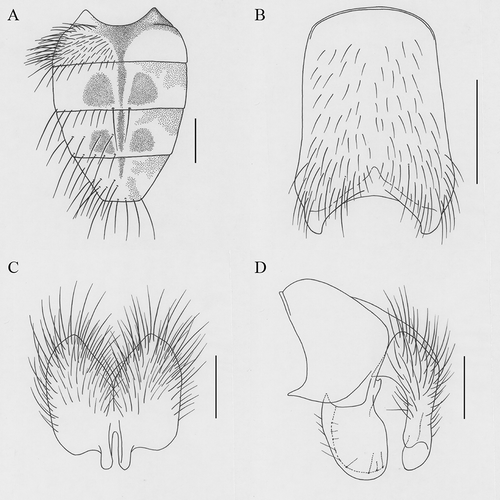
Type material
Holotype
One male (IESNU), China, Snow Mount Baimang, Yunnan Province, 28°18' N, 98°58' E, altitude 4250 m, 26 July 2008, X.D. Fei.
Paratypes
One male (IESNU), same data as holotype.
Etymology
The specific name is based on the habitat of the new species, which is a snow-covered plateau; species was collected on the meadow.
Distribution
China, Yunnan Province, Snow Mount Baimang.
Remarks
This new species is similar to H. maae Xue and Li, Citation2000, but differs from it as follows: eyes with sparse and short ciliae; the longest hairs subequal to the width of postpedicel; cross-vein r-m without distinct cloud; fore tibia with median p, 2 pv; hind tibia with 3 ad; inner protuberance of male cercus longer.
Description (based on holotype)
Male
Body length 8.4–8.6 mm.
Head. Eyes with sparse and short ciliae; frons about 1.0–1.5 times as broad as anterior ocellus; fronto-orbital plate adjoin; frontal vitta black; fr 7–8 pairs on lower three-fifths of frons, without ors; ocellar seta strong, about four-fifths length of fr; fronto-orbital plate and parafacial with grey white pruinosity, parafacial about 1.2 times as broad as postpedicel; antenna black; length of postpedicel about 3.3–3.6 times longer than its width; arista plumose, the longest hairs subequal to the width of postpedicel; lunule dark orange; epistoma not protruding; vibrissal angle situated behind frontal angle; anterior margin of gena with 1–2 rows of upcurved setae; genal and postgenal setulae black; genal height about one-fifth of eye height; epicephalon with hairs; prementum with pruinosity, length about twice as long as height; palpus black, thin and long, about 1.3 times as long as prementum; labella large, both margins of labellum with many rows of dentes, subequal to prementum length.
Thorax
Ground-colour black, with grey to orange grey pruinosity; scutum with four black vittae, inner vitta narrower, about a half width of the middle pale pruinose vitta, reaching the middle of postsutural area of scutum; acr 0+1, dc 2+4, ial 0+2, pra about three-quarters length of posterior notopleural seta, near posterior notopleural seta with many hairs; lateral surface and ventral lateral margin of scutellum with black hairs; basisternum of prosternum, proepisternum hollow in centre, anepimeron and katepimeron all bare; meron with hairs; anterior anepisernal seta 1, katepisternal setae 2+2; anterior and posterior spiracles large and brown.
Wing
With a light orange colour, basicosta orange yellow; costal spine short, Sc bow-shaped, radial node bare, R4+5 and M straight, slightly diverging in distal part, cross-veins r-m and dm-cu not clouded; dm-cu S-shaped curved; calypters yellowish, lower calypter protruding, haltere orange yellow.
Legs
Completely black; fore tibia without ad, with 1 median p; mid femur without distinct av, with 4–5 strong pv in basal half; mid tibia with 3 shorter p, 2 strong pv; hind femur with 4–5 av in apical one-third, 2 of them strong, the longest about 1.5 times as long as the diameter of hind femur, without pv; hind tibia with 5 av, 3 ad, without pd in sub-basal part, with 1 row of setulae (about 7–9) in medial part, without pv in apical part; tarsi longer than tibiae, claws and pulvilli long and large, subequal to tarsomere 5 length.
Abdomen
Ground-colour black, oval in dorsal view, with dense and yellow grey pruinosity; tergites 3 and 4 each with a pair of dark brown patches; the middle of tergites 3 to 5 each with 1 broader and dark grey pruinose vitta (not the median, narrow and black vitta); tergites 3–5 with shifting patches, tergite 5 with 2–3 shifting patches; discal setae 2 rows, about 8 pairs; tergite 4 with 1 row of discal setae, about 4 pairs; tergites 4 and 5 with complete posterior marginal setae; tergite 3 with a pair of strong median marginal setae; body hairs of tergites 2 and 3 dense and short; tergite 6 bare; sternite 1 with hairs.
Distribution
Yunnan (type-locality: Snow Mount Meili)
Helina septentrionalis Xue and Cui, Citation2003
Distribution
Tibet (type-locality: Mount Duoxiongla)
Helina setosiannosa Xue, sp. nov.
(A–D)
Type material
Holotype
One male (IESNU), China, Mount Emei, Sichuan Province, 29°36' N, 103°29' E, altitude 800–1000 m, 8 April 1957, K.R. Huang.
Paratypes
One male (IESNU), China, Mount Emei, Sichuan Province, 29°36' N, 103°29' E, altitude 550–750 m, 29 March 1957, K.R. Huang.
Etymology
The specific name is based on the new species having more setae than H. annosa.
Distribution
China, Sichuan Province, Mount Emei.
Remarks
This new species is similar to H. nemorum (Stein Citation1915), but differs from it as follows: arista long plumose, the longest hairs at least 1.5 times as long as the width of postpedicel; cross-vein r-m clouded; hind tibia with 6 ad; abdomen with shifting patches, sternite 1 with hairs.
Description (based on holotype)
Male
Body length 7.5–8.0 mm.
Head
Eyes with dense and medium long ciliae, the longest cilia equal to the width of postpedicel; the narrowest of frons at least equal to anterior ocellus width; fronto-orbital plate adjoin in the middle; fr 8 pairs on lower half of frons; fronto-orbital plate, parafacial and gena with orange grey pruinosity; parafacial about 1.3 times as broad as postpedicel; antenna black, the length of postpedicel about 4.0 times as long as its width, arista long plumose, the longest hairs at least 1.5 times as long as the width of postpedicel; epistoma not protruding; vibrissal angle situated behind frontal angle; genal height about two-ninths to one-quarter of eye height; anterior margin of gena with 2 rows of upcurved setae; genal and postgenal setulae black; proboscis with pruinosity; length of prementum about twice as long as height; palpus black, longer than prementum.
Thorax
Ground-colour black, with orange grey pruinosity; scutum with 4 distinct black vittae, inner vitta reaching scutoscutellar suture, dorsal surface of scutellum with 1 distinct black vittae, about twice as broad as inner vitta of scutum; acr 0+1, dc 2+4, ial 0+2, pra distinct, about a half to two-thirds length of posterior notopleural seta, notopleuron with hairs around posterior notopleural setae, lateral surface and ventral lateral margin of scutellum with black hairs, basisternum of prosternum and katepimeron all bare, meron with hairs; katepisternal setae 1 (2) +2.
Wing
Transparent, veins brown, basicosta orange yellow, costal spine indistinct, radial node bare, R4+5 and M straight, cross-vein r-m slightly clouded; calypters yellowish, haltere yellow.
Legs
Completely black; fore tibia without median p; mid femur with pv row complete, short and thin towards apex; mid tibia with 4 p; hind femur with av row complete, strong in apical half, the longest hairs about twice as long as the diameter of hind femur, without pv; middle part of hind tibia with 5–7 longer av, 7–8 ad in apical two-thirds, 1 row of longer and pectinate pv (about 7–8) in basal four-fifths; tarsi longer than tibiae, claws and pulvilli medium long.
Abdomen
Ground-colour black, oval in dorsal view, with grey white pruinosity and shifting patches; tergites 3 and 4 each with a pair of subtrigonous and brown patches, tergites 3–5 without distinct median vittae, sternite 1 with hairs.
Female
Unknown.
Helina shii Xue, sp. nov.
(A–H)
Figure 8. Helina shii Xue, sp. nov. (A) Male, abdomen in dorsal view; (B) male, sternite 5 in ventral view; (C) male, cerci in posterior view; (D) male, terminalia in profile; (E) female, sternites 1–5 in ventral view; (F) female, ovipositor in dorsal view; (G) female, ovipositor in ventral view; (H) female, spermatheca. Scale bars: A, E–G, 1 mm; B, 0.5 mm; C, D, H, 0.2 mm.
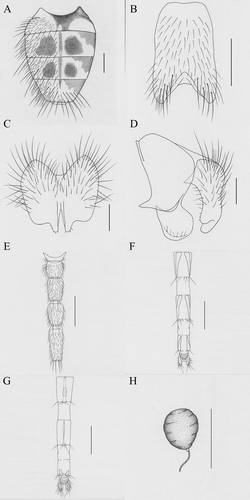
Type material
Holotype
One male (Museum of Hebei University), China, Kowloon HongBa, Sichuan Province, 29°13' N, 102°02' E, altitude 2150 m, 25 April 2008, M.F. Shi.
Paratypes
One male (Museum of Hebei University), same data as holotype.
Etymology
The specific name is based on the name of the collector, Mr Shi Mingfu, with thanks for providing this specimen.
Distribution
China, Sichuan Province, Kowloon HongBa.
Remarks
This new species is similar to H. plumipostitibia Feng and Xue, Citation2002a, but differs from it as follows: hairs of eyes slightly sparse; fr 5 pairs on lower two-fifths of frons; parafacial slightly broader than antenna width; lateral surface and ventral lateral margin scutellum with black hairs; mid tibia except for p in medial, with 1–2 pv; tergite 2 without coupled small patches, sternite 5 thinner and longer; cercus sub-square in posterior view, lateral margin straight, outer protuberance distinct, broader in profile view; surstylus shorter.
Description (based on holotype)
Male
Body length 9.6–9.8 mm.
Head
Eyes with sparse and median long ciliae; frons equal to or larger than anterior ocellus in width; fronto-orbital plates adjoin in medial part, triangle in lower half; frontal vitta black; fr 5 pairs on lower two-fifths of frons, among the setae with short hairs, without ors; inner and outer vertical setae thin, shorter than ocellar seta; fronto-orbital plate and parafacial with copper grey pruinosity, parafacial slightly broader than antenna width; antenna black; length of postpedicel about 3.0 times longer than its width; arista plumose, the longest hairs about 1.0–1.2 times as long as the width of postpedicel; lunule orange; epistoma not protruding; anterior margin of gena with 3–4 rows of upcurved setae; genal height about two-sevenths of eye height; genal and postgena setulae black; dorsal part of occiput with hairs; prementum with pruinosity, length about 2.5 times as long as height; labella large, length about twice as long as the height of prementum; palpus black, longer than the prementum.
Thorax
Ground-colour black, with orange grey pruinosity; scutum with four black vittae, inner vitta reaching the middle of postsutural area of scutum, the middle pale pruinose vita about 1.5 times as broad as the inner vitta; acr 0+1, prst acr 6–7 rows, dc 2+4, ial 0+2, pra about one-half length of posterior notopleural seta, posterior notopleural seta with many short hairs around base, without outer posthumeral setae; lateral surface and ventral lateral margin of scutellum with black hairs; basisternum of prosternum, proepisternum hollow in centre, anepimeron and katepimeron all bare; lower the posterior spiracle of meron with many short hairs; katepisternal setae 2+2; anterior and posterior spiracles large and dark brown.
Wing
Slightly transparent and orange, basicosta yellow; costal spine absent; ventral surface of costa with hairs, other veins bare; Sc bow-shaped; cross-vein r-m clouded, anterior part of r-m slightly curved outward; R4+5 and M diverging in distal part; calypters yellowish, lower calypter tongue-shaped protruding, haltere yellow.
Legs
Completely black; fore tibia with 1 median p; mid femur without distinct av, with 4–5 strong pv in basal half; mid tibia without ad, p 4–5, with 1–2 pv in medial part; hind femur with 3–4 av in apical one-quarter, without pv; hind tibia slightly curved in medial part, with 1 lodging av row (about 7–8) and 1 row of lodging pv (about 7–8) in apical two-fifths, most of them about 1.2–1.3 times as long as the diameter of hind femur, without pv in apical part, ad 4, without pd; tarsi longer than tibiae, claws and pulvilli developed, subequal to or longer than tarsomere 5 length.
Abdomen
Oval in dorsal view, ground-colour black, with grey pruinosity; tergites 3–5 each with 1 median and dark orange vitta, both sides with distinct shifting patches; tergites 3 and 4 each with a pair of large and black brown patches; posterior marginal setae of each tergite and discal setae of tergite 5 all strong; sternite 1 with hairs, terminalia smaller.
Female
Frons about one-third of head in width; frontal triangle reaching the anterior margin of frons; frontal vitta about 4.0 times as broad as frons; fr 4, upper orbital setae 2, inner vertical seta slightly strong, longer than ocellar seta, ciliae of eye slightly short; genal height about one-third of eye height; mid tibia with 2 p, slightly short; hind tibia with 2–3 av in apical half, ad 3–4, without distinct pv, other external characteristics same to male.
Helina shuensis Feng, Citation2000a
Distribution
Sichuan (type-locality: Mount Erlang)
Helina subfloscula Xue, sp. nov.
(A–D)
Type material
Holotype
One male (IESNU), China, Mount Jiajin, Sichuan Province, 30°20' N, 102°25' E, altitude 4000–4100 m, 4 August 2008, L. Chang.
Paratypes
Nine males (IESNU), Mount Jiajin, Sichuan Province, 30°20' N, 102°25' E, altitude 4000–4100 m, 4 August 2008, L. Chang; One male (IESNU), China, Mount Balang, Sichuan Province, 30°39' N, 104°04' E, altitude 4300–4600 m, 3 August 2008, J.Y. Liu.
Etymology
The specific name is based on the similarity of the new species to H. floscula Feng and Xue, Citation2003.
Distribution
China, Sichuan Province, Mount Jiajin, Mount Balang.
Remarks
This new species is similar to H. floscula Feng and Xue, Citation2003, but differs from it as follows. Mid tibia with 1 ad; hind tibia with 1 pd in sub-basal part; sternite 5 longer; cercus sub-square in posterior view, not triangle; outer protuberance distinct, anterior margin of inner protuberance intumescent in profile view.
Description (based on holotype)
Male
Body length 6.5–7.8 mm.
Head
Eyes with long ciliae; frons broad, slightly narrower than the distance between outer margin of posterior ocellus; frontal vitta slightly broader than frons width; 6 pairs of fr on lower three-fifths of frons, without ors; fronto-orbital plate, parafacial and gena with grey pruinosity; parafacia about 1.5 times as broad as postpedicel; antenna black, the length of postpedicel about 2.5 times as long as its width; arista plumose, the longest hairs subequal to the width of postpedicel; epistoma not protruding; vibrissal angle situated behind frontal angle; genal height about one-third of eye height; genal and postgena setulae black; anterior margin of gena with 2 rows of upcurved subvibrissal setula; proboscis short; length of prementum about 2.5 times as long as height; palpus black, longer than prementum.
Thorax
Ground-colour black, with grey pruinosity; scutum with four black vittae, inner vitta reaching scutoscutellar suture, the median pruinose vitta subequal to the width of inner vitta; acr 6–8 rows, only a pair of acr distinct near scutoscutellar suture, acr 0+1, dc 2+4, ial 0+2, pra absent; notopleuron with hairs; colour of scutellum the same as thorax, lateral and lower surfaces of scutellum bare, basisternum of prosternum, katepimeron all bare; lower the posterior spiracle of meron with hairs; katepisternal setae 2+2.
Wing
Slightly with a brown colour, wing-base brown, basicosta orange yellow; costal short, Sc bow-shaped, R4+5 and M straight, cross-veins r-m and dm-cu distinctly clouded; calypters yellow, haltere dark orange.
Legs
Completely black; fore tibia without median p; mid femur av hair-like, 1 row of pectinate and truncated pv in basal two-fifths; mid tibia with 1 ad, 4–5 p in apical two-thirds, the longest about one-quarter of the diameter of mid tibia; hind femur with distinct av row in apical one-third, without pv; hind tibia with 9–10 pectinate av in apical two-thirds, ad 3–4, 3 of them strong, the longest about one-third length of hind tibia, 1 row of pectinate p (about 7–8) in apical three-fifths; tarsi longer than tibiae, claws and pulvilli developed.
Abdomen
Ground-colour black, oval in dorsal view; both sides of abdomen with silver grey pruinosity, dorsal surface with orange pruinosity; tergites 2–5 each with a pair of large black patches; tergites 3 and 4 lateral patches minority and slightly confluent; tergite 5 patches minority and indistinct; sternite 1 with hairs.
Type material
Holotype
One male (IESNU), China, Snow Mount Meili, Yunnan Province, 28°30' N, 98°39' E, altitude 2900 m, 31 May 2013, X. Zhang
Paratypes
One male (IESNU), same data as holotype.
Etymology
The specific name is based on the similarity of the new species to H. nigriabdomilis Xue and Wang.
Distribution
China, Yunnan Province, Snow Mount Meili.
Remarks
This new species is similar to H. nigriabdomilis Xue and Wang, but differs from it as follows. Frons narrower than postpedicel in width, about 1.2–1.5 times as broad as anterior ocellus; 5–6 pairs of fr on lower two-fifths of frons; ocellar seta strong, about five-sixths length of lower fr; fronto-orbital plate and parafacial with brown pruinosity; arista long plumose, most of hairs about 1.2 times as long as antenna width; genal height about three-quarters of eye height; labella shorter than four-fifths length of prementum; prst acr 8–10 rows; ventral lateral margin of scutellum with black hairs; subcostal sclerite with orange hairs; margin of calypter yellow; dm-cu not distinctly clouded; haltere yellow. Fore tibia without p and pv; mid tibia with 6 pectinate p, about 2.2 times as long as the diameter of mid tibia; hind femur with 9–10 av in apical three-quarters; hind tibia with 9–10 av in basal two-thirds, shorter towards apex, 6–7 ad in apical three-fifths, about 2.5-2.7 times as long as the diameter of hind tibia; tarsi distinctly longer than tibiae; tergite 2 not black, middle part with black vitta; tergites 3–5 with distinct shifting patches; sternite 1 bare; lateral lobe of sternite 5 narrower; distal of cercus broader than basal, outer protuberance distinctly intumescent.
Description (based on holotype)
Male
Body length 8.0–8.4 mm.
Head
Eyes with dense, long and orange hairs; frons narrower than postpedicel in width, about 1.2–1.5 times as broad as anterior ocellus; frontal vitta black; 5–6 pairs of fr on lower two-fifths of frons, without ors; ocellar seta strong, about five-sixths length of lower fr; fronto-orbital plate and parafacial with brown pruinosity; middle part of parafacial subequal to antenna width; antenna black, postpedicel thin and long, length about 3.8–4.0 times as long as median width; arista long plumose, most of hairs about 1.2 times as long as antenna width, upper more than lower; lunule dark brown; epistoma not protruding; vibrissal angle situated behind frontal angle; anterior margin of gena with 2 rows of upcurved setulae, genal and postgena setulae black; gena with dark grey pruinosity; genal height about three-quarters of eye height; occiput with dark grey pruinosity; epicephalon with black hairs; prementum with dense and dark grey pruinosity, length about 2.2 times as long as height; labella larger, posterior part extended in upward direction, shorter than four-fifths length of prementum; palpus black, about 1.2 times as long as prementum;
Thorax
Ground-colour black; pleura with dark grey pruinosity; scutum with dense and orange grey pruinosity and 4 dark black pruinose vittae, inner vitta reaching the posterior of postsutural area of scutum; prst acr 8–10 rows, only a pair of acr strong near scutoscutellar suture; dc 2+4, ial 0+2, pra long and setiform, about three-fifths length of posterior notopleural seta, postpronotal setae 3, posthumeral seta 1+0; posterior notopleural seta with hairs around base; basal and apical scutellar setae strong, lateral scutellar setae 2 pairs, lateral surface and ventral lateral margin of scutellum with black hairs; basisternum of prosternum, proepisternum hollow in centre, anepimeron and katepimeron all bare, meron with thin hairs; anterior anepisernal seta 1; anepisternal setae without hairs between the first and the second, among the other setae with thin hairs; katepisternal setae 2+2; anterior and posterior spiracles larger and dark brown; anatergite with orange black hairs; greater ampulla bare.
Wing
With a brownish colour, basicosta yellow, subcostal sclerite with orange hairs; costal spine short, Sc bow-shaped, radial node bare, R4+5 and M straight, diverging in distal part; cross-vein r-m distinctly clouded; calypters light orange, lower calypter tongue-shaped protruding, margin of calypter yellow, haltere yellow.
Legs
Completely black; fore tibia without p and pv; mid femur av indistinct, with pv row complete, shorter towards apex, 6–7 strong in basal half; mid tibia without ad, pectinate p 6, about 2.2 times as long as the diameter of mid tibia; hind femur with 9–10 av in apical three-quarters, without pv; hind tibia with 9–10 av in basal two-thirds, shorter towards apex, most of setae about 2.5–2.7 times as long as the diameter of hind tibia, median long ad row (about 7) in apical three-fifths, about 2.5–2.7 times as long as the diameter of hind tibia, without pd, 8–9 pv in basal two-thirds, shorter towards apex, 1 d in pre-apical part, without pv in apical part; tarsi distinctly longer than tibiae, claws and pulvilli of fore leg about 1.5 times as long as the tarsomere 5, claws and pulvilli of middle and hind legs about 1.2 times as long as the tarsomere 5.
Abdomen
Ground-colour black, with greyish pruinosity; oval in dorsal view; tergite 2 grey, tergites 2–5 with median, narrow and black vitta; tergites 3–5 each with a pair of black patches and shifting patches, lateral patches on tergite 5 smaller, outline indistinct; discal setae 2 rows; body hairs of tergite 2 denser, body hairs of each posterior tergite gradually sparse; posterior marginal setae of middle part of tergite 2 shorten; sternite 1 bare; posterior marginal setae of sternites 2–4 longer; lateral lobe of sternite 5 narrower; distal of cercus broader than basal, outer protuberance distinctly intumescent.
Distribution
Xinjiang (type-locality: Jengish Chokusu) Helina xinanana Feng, Citation2000b
Distribution
Sichuan (type-locality: Mount Erlang)
Geolocation information
Point (Helina longievecta): 38°28′ N, 106°15′ E; Point (Helana longisurstyla): 26°57′ N, 99°01′ E; Point (Helina midmargiseta): 28°18′ N, 98°58′ E; Point (Helina nigriabdomilis): 30°02′ N, 101°57′ E; Point (Helina nivimonta): 28°18′ N, 98°58′ E; Point (Helina setosiannosa): 29°36′ N, 103°29′ E; Point (Helina shii): 29°13′ N, 102°02′ E; Point (Helina subfloscula): 30°20′ N, 102°25′ E; Point (Helina subnigriabdomilis): 28°30′ N, 98°39′ E
TNAH_954019_Geo-coordinates.xls
Download MS Excel (18 KB)Acknowledgements
This study was supported by the National Nature Science Foundation of China (No. 30870330 and 31172139), the Ministry of Science and Technology of the People’s Republic of China (MOST grant no. 2006FY110500) and the Foundation of Experimental Centre of Shenyang Normal University (SYZX200902). Special thanks are due to M.F. Shi, K.R. Huang, J.Y. Liu, Y. Zhao, X.D. Fei, L. Chang and X. Zhang for giving us invaluable help and providing materials.
References
- De Carvalho CJB, Couri MS, Pont AC, Pamplona D, Lopes SM. 2005. A Catalogue of the Muscidae (Diptera) of the Neotropical Region. Zootaxa. 860:1–282.
- Emden FIvan. 1951. Muscidae C. – scatophaginae, anthomyiinae, lispinae, finniinae and phaoniinae. Ruwenzori Expedition 1934–35. 2:325–710.
- Emden FIvan. 1965. The Fauna of India and the adjacent countries. Diptera, Volume 7, Muscidae, part 1. Delhi: Government of India; p. 1–647.
- Fan ZD. 1992. Key to the common flies of China. 2nd ed. Beijing: Science Press; p. 338–440.
- Fang JM, Fan ZD. 1993. Diptera: Muscidae (I). In: Chen SX, editor. Insects of the Hengduan mountains region, Volume 2. Beijing: Science Press; 1220–1251.
- Feng Y. 2000a. Three new species of Muscidae from western Sichuan, China (Diptera: Muscidae). Chin J Vector Biol Control. 11:81–85.
- Feng Y. 2000b. Five new species of Muscidae (Diptera) from Sichuan, China. Entomotaxonomia. 22:53–60.
- Feng Y. 2000c. Eight new species of the Muscidae from Sichuan, China (Diptera: Muscidae). Sichuan J Zool. 19:3–7.
- Feng Y. 2000d. Five new species of the genus Helina (Diptera: Muscidae) from Sichuan Province, China. Entomotaxonomia. 27:114–120.
- Feng Y. 2004. Four new species of the genus Helina (Diptera: Muscidae) from western Sichuan Province, China. Acta Parasitologica Med Entomologica Sinica. 11:91–95.
- Feng Y. 2005. Five new species of the genus Helina (Diptera: Muscidae) from Sichuan, China. Entomotaxonomia. 27:114–122.
- Feng Y. 2007. Five new species of the genus Helina (Diptera: Muscidae) from western Sichuan, China. Entomol J East China. 16:161–167.
- Feng Y, Xue WQ. 2002a. Five new species of the genus Helina (Diptera: Muscidae) from Sichuan, China. Entomotaxonomia. 24:261–268.
- Feng Y, Xue WQ. 2002b. Three new species of the genus Helina from Sichuan, China (Dipteral: Muscidae). Sichuan J Zool. 22:3–5.
- Feng Y, Xue WQ. 2003. Four new species of Helina from Sichuan, China (Diptera: Muscidae). Entomol J East China. 12:5–9.
- Feng Y, Yang SB, Fan WD. 2004. Two new species of genus Helina from western Sichuan, China (Diptera: Muscidae). Sichuan J Zool. 23:319–321.
- Guan YH, Feng Y, Ma ZY. 2001. A new species of Helina R.-D. from China, (Dipteral: Muscidae). Chin J Vector Biol Control. 12:166–167.
- Harris M. 1780. Expos. Eng. Ins. London. p. (4): 125.
- Hennig W. 1957–1958. Muscidae (part). In: Lindner E, editor. Die Fliegen der palaearktischen Region, 63b. Stuttgart: Schweizerbart; p. 145–232.
- Huckett HC. 1965. The Muscidae of northern Canada, Alaska, and Greenland (Diptera). Memoirs Entomol Soc Can. 42:1–369. doi:10.4039/entm9742fv
- McAlpine JF. 1981. Morphology and terminology – adults. In: McAlpine JF, Peterson BV, Shewell GE, Teskey HJ, Vockwroth JR, Wood DM, coordinators. Manual of Nearctic Diptera. Volume 1. Agriculture Canada Monograph 27. Hull: Canadian Government Publishing Center; p. 9–63.
- Pont AC. 1977. Family Muscidae. In: Delfi-nado MD, Hardy DE, editors. A catalogue of the diptera of the oriental region, Volume 3, Suborder Cyclorrhapha (excluding Division Aschiza). Honolulu: University Press of Hawaii; p. 451–523.
- Pont AC. 1980. Family Muscidae. In: Crosskey RW, editor. Catalogue of the diptera of the afrotropical region. London: British Museum (Natural History); p. 721–761.
- Pont AC. 1986. Family Muscidae. In: Soós Á, Papp L, editors. Catalogue of palaearctic diptera, Volume 11, Scatophagidae–Hypodermatidae. Budapest: Akadémiai Kiadó; p. 57–215.
- Pont AC. 1989. 107. Family Muscidae. In: Evenhuis, NL, editor. Catalog of the Diptera of the Australasian and Oceanian Regions. Special Publications of the Bernice Pauahi Bishop Museum. 86:675–699. Honolulu: Bishop Museum Press, and Leiden: E.J. Brill.
- Qian WP, Feng Y. 2005. Three new species of genus Helina from China (Diptera: Muscidae). Chin J Vector Biol Control. 16:258–260.
- Ringdahl O. 1924. Översikt av de hittills i vart land funna arterna tillhörande släktena Mydaea R.-D., och Helina R.-D. (Muscidae). Entomologisk Tidskrift. 45:49–66.
- Ringdahl O. 1949. Forsök till artgruppering inom släkene Phaonia R.-D., och Helina R.-D. (fam. Muscidae). Entomol Tidsk. 70:136–146.
- Ringdahl O. 1956. Tvåvingar. Diptera Cyclorapha Schizophora Schizometopa. 1. Fam. Muscidae. Häfte 2. Svensk Insektfauna. 11. Stockholm: Almqvist and Wiksell; p. 93–195.
- Skidmore P. 1985. The biology of the Muscidae of the world. Ser Entomologica. 29:1–550.
- Stein P. 1915. H. Sauter’s Formosa-Ausbeute, Anthomyidae (Diptera). Supplementa Entomol. 4:13–56.
- Wang MF. 2013. New synonymies and new combinations of Muscidae from China (Diptera, Muscoidea). ZooKeys. 290:31–38. doi:10.3897/zookeys.290.4811
- Wang MF, Xue WQ, Ni YT, Wang CJ, Lu YL. 1990. Studies on Muscidae from Shanxi Province of China (Diptera). Paper presented at: The 2nd International Congress of Dipterology; Czechoslovakia.
- Wang MF, Xue WQ, Zhang D. 2004. Notes on annosa Species-group of Helina R.-D. (Diptera: Muscidea) in China. Entomologia Sinica. 11:293–301.
- Wang MF, Zhang D, Wang RR. 2008. Two new species of the genus Helina Robineau-Desvoidy (Diptera: Muscidae) from China with revised diagnosis on the Chinese species. Annales de la Société entomologique de France. 44:139–144. doi:10.1080/00379271.2008.10697550
- Wu JW. 1989. Five new species of the genus Helina from Gansu, China (Diptera: Muscidae). Entomotaxonomia. 11:323–332.
- Wu YQ, Fang JM, Fan ZD. 1988. Descriptions of six new species of Phanniinae from Shaanxi Province, China (Dipt. Muscidae). J Med Col PLA. 3:388–392.
- Xie GA, Qian WP, He JH, Hu YJ, Feng Y, Li ZD. 2008. A new species of the genus Helina from northern Sichuan of China (Diptera: Muscidae). Med Anim Prev. 24:644–645.
- Xue WQ. 1985. Two new species of the genus Helina from Liaoning, China (Diptera: Muscidae. Acta Entomologica Sinica. 28:104–106.
- Xue WQ. 1998. Muscidae. In: Xue WQ, Chao CM, editors. Flies of China, Volume 1. Shenyang: Liaoning Science and Technology Press; p. 1116–1165.
- Xue WQ. 2001. Two new species of the genus Helina R. -D. (Diptera: Muscidae) from Xinjiang, China. Entomotaxonomia. 23:35–37.
- Xue WQ, Cui CY. 2003. Four new species of the genus Helina Robineau-Desvoidy from Heilongjiang, China (Diptera: Muscidae). Acta Entomologica Sinica. 46:76–79.
- Xue WQ, Feng Y. 2002. Five new species of the genus Helina from Sichuan Province, China (Diptera: Muscidae). Zool Res. 23:499–503.
- Xue WQ, Li FH. 2000. Five new species of genus Helina R.-D. from Yunnan, China (Diptera: Muscidae). Zool Res. 21:303–307.
- Xue WQ, Tian X. 2011. Notes on six synonyms of Helina from China (Diptera: Muscidae). J Shenyang Normal Univ Nat Nat. 29:428–430.
- Xue WQ, Tian X. 2012. Thirteen new species of the genus Helina R.-D. (Diptera: Muscidae) from China. J Nat Hist. 46:565–598. doi:10.1080/00222933.2011.651632
- Xue WQ, Wang MF. 1989. Studies on calypterate flies from northern Shanxi, China. II. descriptions of three new species of the Muscidae (Diptera). Acta Entomol Sinica. 32:230–234.
- Xue WQ, Wang S, Tian X. 2012. A review of species-groups and description of two new species of Helina (Diptera: Muscidae) from China. Oriental Insects. 46:107–115. doi:10.1080/00305316.2012.689486
- Xue WQ, Zhao BG, Li SZ. 1989. Studies on calypteratae flies from Hebei, China (1), (Diptera: Muscidae). Acta Entomologica Sinica. 32:92–96.
- Zetterstedt JW. 1838. Sectio tertia. Diptera. Dipterologis Scandinaviae amicis et popularibus carissimus. In: Insecta Lapponica. Lipsiae: L. Voss; p. 477–868.

